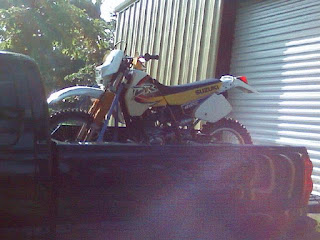Riding my first Husqvarna, I entered as many enduros as I could. Most of my weekend buddies had drifted away and the family would load up the van for a weekend trip to places like Ball Ground and Dahlonega, Georgia, Calhoun Falls, South Carolina, Big Stone Gap, Virginia, Cadiz, Kentucky, Sand Mountain, Alabama and all over Tennessee. We would camp out at mostly primitive sites. Sometimes in less than perfect conditions. At one race in Georgia we had pitched the tent along a ridge. Linda and Jennifer were in the van and the boys and I were in the tent. Some times during the night a scary thunderstorm came through. All five of us ended up sleeping in the van.
One enduro I left home without my helmet. I wanted to blame someone, but couldn't as it was my fault. A stranger loaned me a helmet and I did pretty well. Another time Linda lost my jeans at the washteria and I had to wear my double knit bell bottoms to the staging area.
In addition to trophies, all entrants received a patch for riding the enduro. By 1975 I was starting to collect a number of patches, but had not won a trophy yet. I had joined the Southeast Enduro Riders Association and the AMA. I started as a C-Class rider and was building points. There were very few National Enduros so it was hard to accumulate points when you were finishing 50th with the "Big Boys".
I finally started keeping time after I hit some check points HOT (early). This required a strip chart with mileage and all the turns and terrain listed, an accurate watch and the ability to know how to convert 24mph to 0.2mile. Paying attention to the time was not that difficult, riding well enough to make a difference was.
My first trophy came on a hare scramble in North Alabama. A Hare Scramble or Hare and Hound is a race. No time keeping, fastest time wins. They are somewhat of a cross between motocross and enduros. Usually fifty to 80 miles on a course made up of five to ten mile laps. It had been raining prior to the race and started snowing the morning of the event. Three or four of my friends entered. It was awful. Mud and more mud. It took forever to make a lap. The organizers finally stopped the race. I had gone about three laps but was ahead of all but two in my class. Picking up a third place trophy.
The next day at work was miserable. Since motorcycles were not popular with DuPont, I had managed to keep my hobby a secret at work. When I showed up that Monday I looked and felt pretty bad. My boss looked a me and said, "what's wrong"? I replied, "Nothing". He said, "You were out playing in the snow all day yesterday, weren't you". I didn't have to lie, just said, "Yes Sir".

(In the picture I'm wearing a Honda jersey. As I mentioned in previous blogs, I was cheap. I never raced a Honda, but I needed a jersey and this one was on sale.)
Enduro participation was open to anyone regardless of ability. Most were classed by motorcycle displacement.
Usually 125cc, 200cc, 250cc and Open. You might be riding against a guy wearing cowboy boots and a plastic rain suit or a world class rider. One such hare scrambled took place not far from home.
There was a three race hare scramble series scheduled near East Brainerd, Tennessee. I was still riding my 1974 Husky and getting better. I planned to enter all three races. The course was an 80mile run, made up of 10 eight mile laps. It was a well laid out course, that included some rocky sections, a steep hill or two, a really fast open section, a creek crossing and around several turnip fields. The first of the three races occurred on another one of those really rainy days. By then most of the competitive riders rode either Husqvarna or Penton dirt bikes. Penton's HQ was in Ohio and Husky had a major sales office outside Nashville. At the start of the first race, I noticed that there were three Husky Factory sponsored riders. Some "Big Boys" showed up for the local race. The course was tough. The turnip fields were getting muddier and muddier with each lap and the creek crossing was getting deeper. That day I found out the difference between a world class rider and a Class C local yokel. One of the factory riders lapped me twice. I can remember "dog paddling" through the turnip patch when one of them blew by me. I finished the race and actually got third in my class. No trophy, but I was given $10 for my performance. I had lost my amateur standing.
A month later the second leg of the series was scheduled and Penton sent 11 factory riders to compete with Husqvarnas. Two of the three Penton brothers were there and one of them was the overall winner.
The third race was uneventful. I do recall a kid riding a 125cc Hodaka passing me in a wide open field. And Mike dragging a big rock that looked like Texas with his 50cc Honda mini bike. We went back the next week and got the rock. It is in our flower bed today
I ended my Pro Career with a total winnings of ..........Ten Dollars.
In 1976 I moved up in the amateur ranks.


